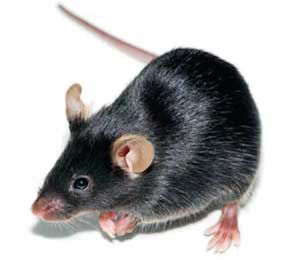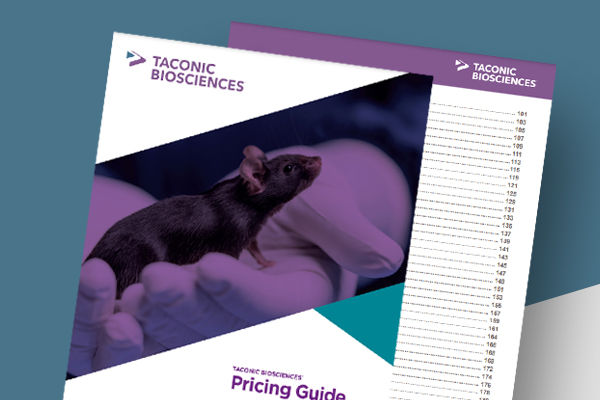| Model No. | Nomenclature | Genotype |
|---|---|---|
| 2334-F | B6.129S6-Rag2tm1Fwa Tg(TcraTcrb)1100Mjb | ko/ko;tg/tg |
| 2334-M | B6.129S6-Rag2tm1Fwa Tg(TcraTcrb)1100Mjb | ko/ko;tg/tg |
Rag2/OT-I

- Description
- Price & Licensing
- Health Report
- Overview
- Genetics
- Guides & Publications
- Applications & Therapeutic Areas
- Transit, Housing & Welfare
- Diet
Overview
Nomenclature: B6.129S6-Rag2tm1Fwa Tg(TcraTcrb)1100Mjb
- Carries a transgene that encodes a T cell receptor (Valpha2-Jalpha26 and Vbeta5-Dbeta2-Jbeta.6) specific for a chicken ovalbumin peptide fragment (257-264) presented by the MHC class I molecule H2-Kb
- Deficient in the recombination activating gene 2 (Rag2) and therefore does not develop mature T or B cells expressing endogenous T cell receptors
- Virtually all peripheral CD8+ cells express the transgene
- Useful as a source of homogenous donor CD8+ T cells for in vivo adoptive transfer studies to investigate T cell development, activation, memory and tolerance
- Please note that detailed research into T cell lineage commitment in OT-I transgene bearing mice, including mice from line 2334, revealed that Cd8- Cd4+ T cells can spontaneously develop in some animals. These OT-I positive, Cd4+ T cells appear in addition to the expected population of canonical Cd8+ OT-I+ T cells. This population of Cd4+ T cells are nominally MHC class I restricted, as discussed in Ge et al. In such mice, the Cd4+ T cells expand in the periphery with age. If this cell population is problematic for your experiment, we recommend using young mice for experiments (5-6 weeks) and/or performing additional purification/enrichment steps after cell harvest. Ge et al. (2006) Proc Natl Acad Sci U S A. 103(6):1822-7.
Origin
The OT-I microinjected model was developed by Dr. Francis Carbone of Monash Medical School and Dr. Michael Bevan of the University of Washington. The model was created by injecting the rearranged T cell receptor Valpha2-Jalpha26 (under the control of the alpha chain promoter and enhancer) and Vbeta5-Dbeta2-Jbeta2.6 (under the control of the MHC class I promoter and the Ig heavy chain enhancer) into B6 x B6.C-H2bm1 blastocysts. The resultant founders were then backcrossed to C57BL/6. Taconic received stock from Keio University in June 2001, and the mice were rederived by backcrossing to C57BL/6NTac. OT-I transgenic mice were crossed with a homozygous C57BL/6NTac Rag2 targeted mutation model (RAGN12-M), and intercrossed for homozygosity at the Rag2 allele. The model was rederived by embryo transfer and is maintained by mating of male and female mice homozygous for both the Rag2 disruption and the OT-I transgene.
Genetics
Guides & Publications
Initial Publication:
Shinkai, Y, Rathbun, G, Lam, KP, Oltz, EM, Stewart, V, Mendelsohn, M, Charron, J, Datta, M, Young, F, Stall, AM, and Alt, FW. (1992) RAG-2-Deficient Mice Lack Mature Lymphocytes Owing to Inability to Initiate V(D)J Rearrangement, Cell, 68: 855-867.
Hogquist KA, Jameson SC, Heath WR, Howard JL, Bevan MJ, Carbone FR. (1994) T cell receptor antagonist peptides induce positive selection. Cell 76: 17-27.
Applications & Therapeutic Areas
- Autoimmune Disease
- Immunology
- Inflammation
Transit, Housing & Welfare
Need more info? Click the live chat button or Contact Us
Packing Practices
Taconic standard practice is to recombine animals of different home cages and/or ages from a single model and sex during packing, except in specific cases where Taconic's animal welfare policy prohibits recombination due to aggression or other concerns. When an order is fulfilled with animals from more than one week of birth, this standard practice results in animals from a range of birth weeks packed together in a single TTC. When an order is fulfilled with animals from genotyped models, this standard practice results in animals from different home cages packed together in a single TTC.
Customers who wish to keep animals from different weeks of birth separated should place orders with the special instruction "Divide and label by age." Note that this special request can result in increased costs for additional Taconic Transit Cages, dividers and/or freight charges.
Taconic discourages other types of custom packing requests as they can have a negative impact on animal welfare. Learn more.
Diet
- Licensing
- Pricing - USD
- Pricing - EUR
- Pricing - USD Nonprofit
- Pricing - EUR Nonprofit
- Select my Health Standard
- Get Custom Pricing Guide
Rag2/OT-I
Conditions of Use for Taconic Transgenic Models™
Taconic Transgenic Models™ (Models) are produced and distributed under rights to patents and intellectual property licensed from various institutions. Taconic sells the Models to purchasers, grants to each purchaser a right under Taconic's rights in such licensed patents and intellectual property to use the purchased Model in consideration of purchasers' acknowledgement of and agreement to the Terms and Conditions for Taconic Models, Products and Services and the following terms of use:
- Title to these Models and biological materials derived from them remains with Taconic.
- The Models will be used for research purposes only.
- The Models will not be bred or cross-bred except to obtain embryos or fetuses required for research purposes unless additional rights have been granted in writing by Taconic.
- The Models and biological materials derived from them will not be distributed to third parties or used for commercial purposes.
- Non-profit purchasers may not use this Model and/or biological materials derived from it in sponsored research or contract research studies unless it is purchased at the for-profit price.
Pricing - USD
Murine Pathogen Free (MPF) Health Standard
2334 Female
2334-F Genotype ko/ko;tg/tg
Available now
| Age in Weeks | Quantity 1 - 999 |
|---|---|
| 3 to 10 | $ 323.00 |
2334 Male
2334-M Genotype ko/ko;tg/tg
Cohorts are reserved upon order placement and will take 2-4 weeks to fulfill. An estimated lead time will be provided to you within 2-3 business days.
| Age in Weeks | Quantity 1 - 999 |
|---|---|
| 3 to 10 | $ 323.00 |
Pricing - EUR
Murine Pathogen Free (MPF) Health Standard
2334 Female
2334-F Genotype ko/ko;tg/tg
Available now
| Age in Weeks | Quantity 1 - 999 |
|---|---|
| 3 to 10 | 294,00 € |
2334 Male
2334-M Genotype ko/ko;tg/tg
Cohorts are reserved upon order placement and will take 2-4 weeks to fulfill. An estimated lead time will be provided to you within 2-3 business days.
| Age in Weeks | Quantity 1 - 999 |
|---|---|
| 3 to 10 | 294,00 € |
Pricing - USD Nonprofit
Murine Pathogen Free (MPF) Health Standard
2334 Female
2334-F Genotype ko/ko;tg/tg
Available now
| Age in Weeks | Quantity 1 - 999 |
|---|---|
| 3 to 10 | $ 323.00 |
2334 Male
2334-M Genotype ko/ko;tg/tg
Cohorts are reserved upon order placement and will take 2-4 weeks to fulfill. An estimated lead time will be provided to you within 2-3 business days.
| Age in Weeks | Quantity 1 - 999 |
|---|---|
| 3 to 10 | $ 323.00 |
Pricing - EUR Nonprofit
Murine Pathogen Free (MPF) Health Standard
2334 Female
2334-F Genotype ko/ko;tg/tg
Available now
| Age in Weeks | Quantity 1 - 999 |
|---|---|
| 3 to 10 | 294,00 € |
2334 Male
2334-M Genotype ko/ko;tg/tg
Cohorts are reserved upon order placement and will take 2-4 weeks to fulfill. An estimated lead time will be provided to you within 2-3 business days.
| Age in Weeks | Quantity 1 - 999 |
|---|---|
| 3 to 10 | 294,00 € |
Select my Health Standard
Need help choosing the right Taconic Biosciences health standard for your research?
Use the Health Standard Selector to enter your exclusion list. The tool will tell you which health standards meet your requirements.
Get custom pricing guide
Schedule A Scientific Consultation
Speak with a PhD-level Field Application Scientist who can help you select the most appropriate model and maximize your experimental success.















.jpg)

.jpg)
.jpg)
.jpg)
.jpg)





.jpg)


.jpg)
.jpg)

.jpg)


.jpg)





.jpg)

.jpg)







